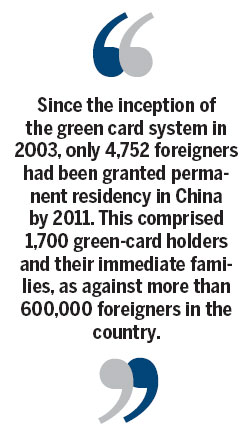China must tweak its green card system further to attract more overseas professionals
After clocking steady growth, China's overseas direct investment is expected to top $100 billion (74 billion euros) this year, compared with $72.2 billion last year. Though this is a commendable feat, it means that China needs more global talent to sustain its steady economic growth and expansion in global markets.
Lending further credence to these statements is the fact that there is an acute scarcity of high-level, innovative talent in China. According to recent estimates, there are only 10,000 high-level and innovative technology talents in China working on new energy industries, energy conservation, environmental protection, new materials and other allied industries.
Interestingly, most of these sectors have been earmarked as strategic emerging industries in China's 12th Five-Year Plan (2011-15) and are the driving force for its future economic development. Not surprisingly, these are also sectors that are in desperate need of foreign talent.
At the same time, there are several reasons why foreign talent has not been so plentiful in China. While the liberalized exit and entry regulations have helped bring in more foreigners, tough green card regulations have prevented the flow of top-level talent.
Since the inception of the green card system in 2003, only 4,752 foreigners had been granted permanent residency in China by 2011. This comprised about 1,700 professionals working in China and their immediate families, as against more than 600,000 foreigners in the country. With such a small percentage of green-card holders, it is natural for most of the overseas talent to feel that they are just "foreigners" in China.

According to official data, the average number of green cards issued every year in China is 248, whereas the number of foreigners coming in every year is about 2.7 million.
It is also interesting that most green-card holders in China are top talents introduced by various official programs. Though furthering research and innovation has been the focus of these official programs, many of the top talents have since moved on to managerial positions. While this move has not paid off in some cases, it is important for China to come up with a proper technology immigration system.
The real crux of the current green card system is that it centers more on making the talent fit in with China's requirements, and hence does not much favor foreign job seekers.
For instance, foreign graduate students are not permitted to work in China, as there are no legal provisions for their employment. But there is hope as the government is working on rules to facilitate formal talent exchanges between Chinese employers and foreign students.
Zhongguancun in Beijing is a good example of an innovation district, which has the potential to be the second Silicon Valley, that banks on the power of technology talent and foreign students.
China has undergone enormous economic changes in the past 30 years and now faces several important decisions on how best to sustain economic growth. At the same time, its population is aging rapidly and the 225 million migrant workers who have fueled economic success in the past are now demanding better payment for their work. Further complicating the situation is the growing number of college students entering the job market.
Attracting and retaining highly skilled overseas talent has far-reaching implications for China's efforts to build an innovation-driven economy by 2020 and offers valuable insights for the global business and policy communities.
The author is director general of the Center for China & Globalization, an independent, non-profit think tank based in Beijing.
(
China Daily European Weekly 12/13/2013 page11)








